Rugby and HIA risk (thread):
Ahead of a big rugby weekend, thought I'd offer a little insight into when the risk of head injuries is highest, and how World Rugby has tried to nudge behaviour towards safety (the Red and Yellow cards you see, that is). So here's a little tutorial!
Ahead of a big rugby weekend, thought I'd offer a little insight into when the risk of head injuries is highest, and how World Rugby has tried to nudge behaviour towards safety (the Red and Yellow cards you see, that is). So here's a little tutorial!
First, and sorry for the wordy slide, but we need to understand how risk reduction works in the global sense. To simplify, you're either eliminating, substituting, or modifying what is risky. To do this, you have to first understand a spectrum of risk. That is, "what is risky?" 

Here's another slide (fewer words) that illustrates that, shows the spectrum of risk idea, and also introduces the idea of modifying a behaviour to lower overall risk. This concept underpins what happens next, which is the data part of the process. (3/ 

Since 2016, we've pretty much continuously been studying how Head injuries (HIAs, in rugby) happen. We have a dataset of over 800 now, 607 of which are in tackles, and we also have 5417 "control" tackles that don't cause HIA, for comparison. (4/ 
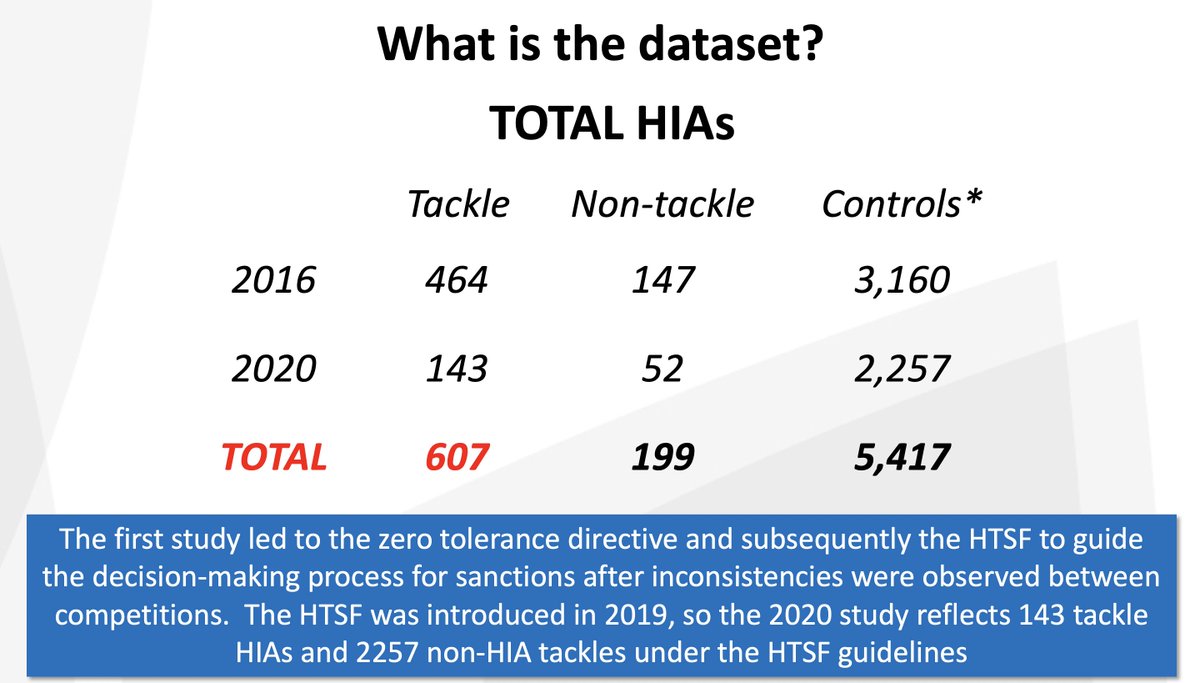
The control group vs HIA group comparison is important, because it allows us to say "OK, we know what a tackle that causes an HIA looks like compared to one that doesn't". In other words, safe vs risky. This allows us to calculate a propensity for HIA from different situations 
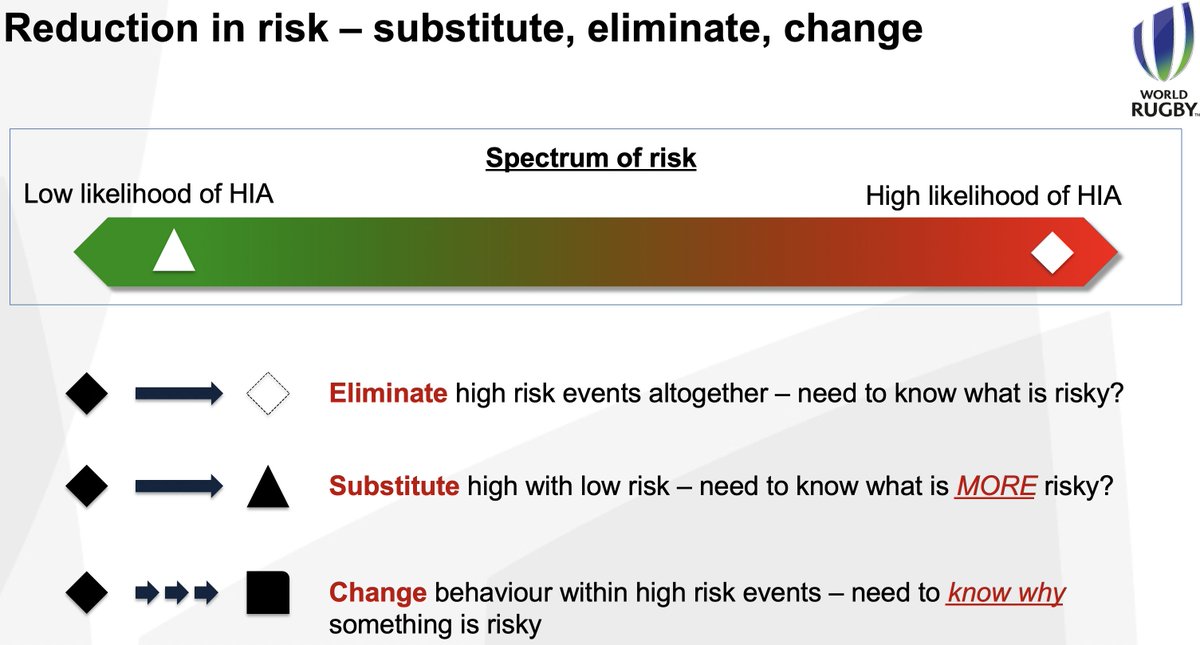
PROPENSITY is risk per 1000 tackles. Or we can express it as "HIAs per X tackles of that kind". Here is a slide that shows propensity for HIA for different types of head contacts. For example, head to head causes an HIA once every 88 occasions (11.3 per 1000 instances). 

It should be immediately apparent that head-to-head creates the greatest risk. This is true for BOTH tackler AND ball carrier (not shown, but I'll give you a reference later). Then comes elbow, knee, hip. On the 'safe" end are upper leg & upper body (1 in 1700+, or 0.4 per 1000) 

When we group tackles by those ABOVE a line of the sternum (blue line below) and those below the sternum, we get a split between high contacts, and low contacts. The risk ABOVE the line is 3.8 per 1000, below the line is 0.9 per 1000. So, HIGH is 4.3x more risky than low. 
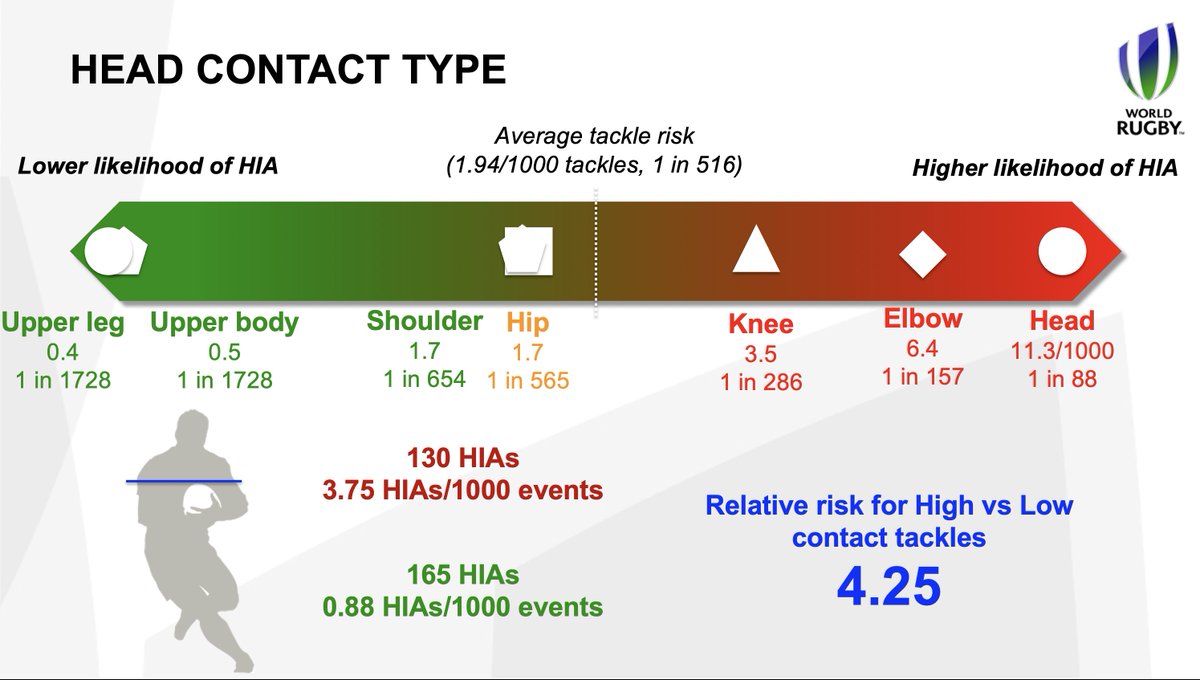
Then another finding - body position of players. The slide below is quite dense and busy, but I'll try to explain it systematically. You have a tackler and Ball Carrier (BC), and they can be upright, bent or diving (to simplify). What is the risk of each situation? 
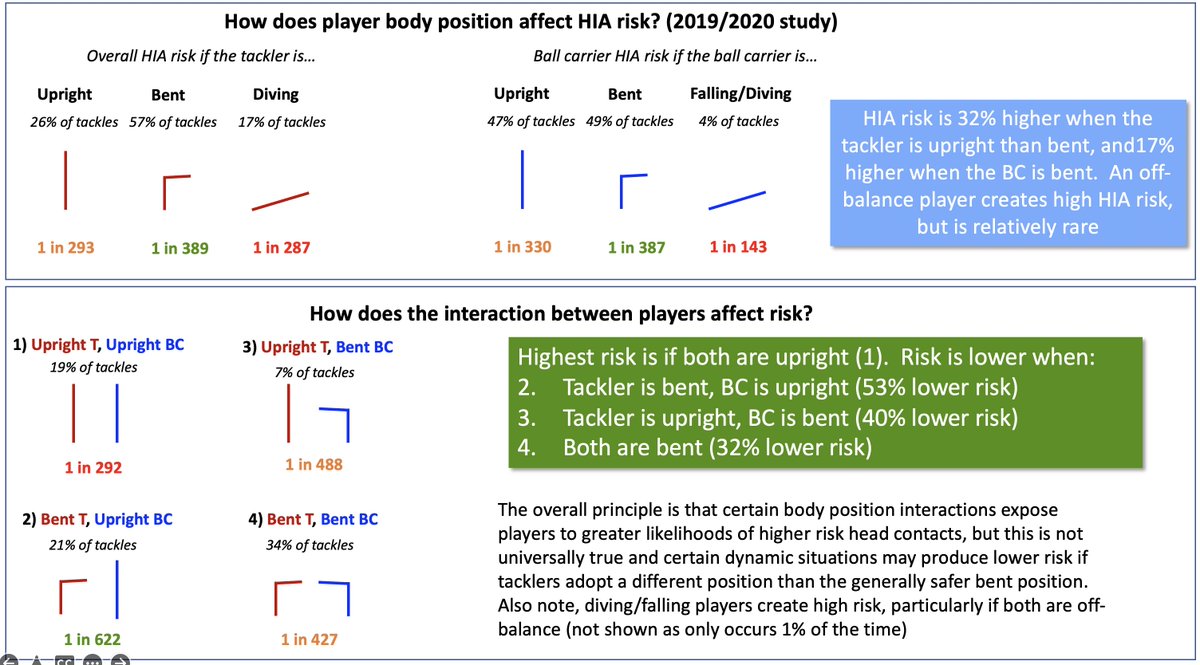
Let's start at the top, and consider the body position of tacklers and BCs separately. If the tackler is upright (red square), HIAs happen every 293 tackles. When bent, it's 1 in 389, and when diving, 1 in 287. So the 'safer' position is bent, while diving is riskiest 

This risk to a diving tackler is not hard to understand - they're off balance, with risk of hitting the ground & the opponent. It's also a kind of "unmodifiable behaviour", so focus has been on the upright vs bent positions. Risk here:
1 in 293 upright - high
1 in 389 bent - low
1 in 293 upright - high
1 in 389 bent - low

Let's now look at the same for the BC. The pattern is identical:
Lowest risk - bent BC, 1 in 387
Middle risk - upright BC, 1 in 330
Highest risk - diving BC, 1 in 143. Again, diving affects vision, balance, preparation for impact etc. It only happens in 4% of all tackles, though
Lowest risk - bent BC, 1 in 387
Middle risk - upright BC, 1 in 330
Highest risk - diving BC, 1 in 143. Again, diving affects vision, balance, preparation for impact etc. It only happens in 4% of all tackles, though

Collectively, looking at the T and BC independently creates a picture where:
🏉 Diving impacts are high risk, but fortunately rare
🏉 For both players, being upright creates more risk than being bent. This is again true for BOTH players, whose risk increases if upright.
🏉 Diving impacts are high risk, but fortunately rare
🏉 For both players, being upright creates more risk than being bent. This is again true for BOTH players, whose risk increases if upright.
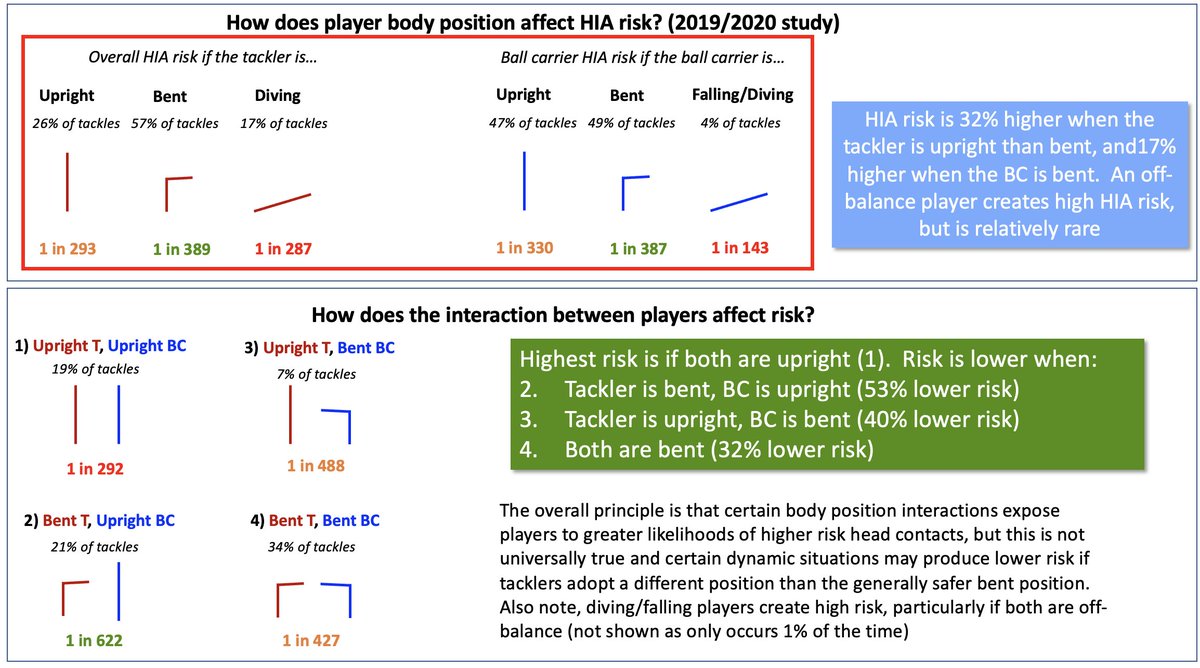
Now, since you're a sharp and discerning bunch (!), I know you're thinking "what about the interaction between the players? Well, let's look at that, bottom left of the slide below. We look at upright vs bent only, because they're deemed more modifiable and are far more common 
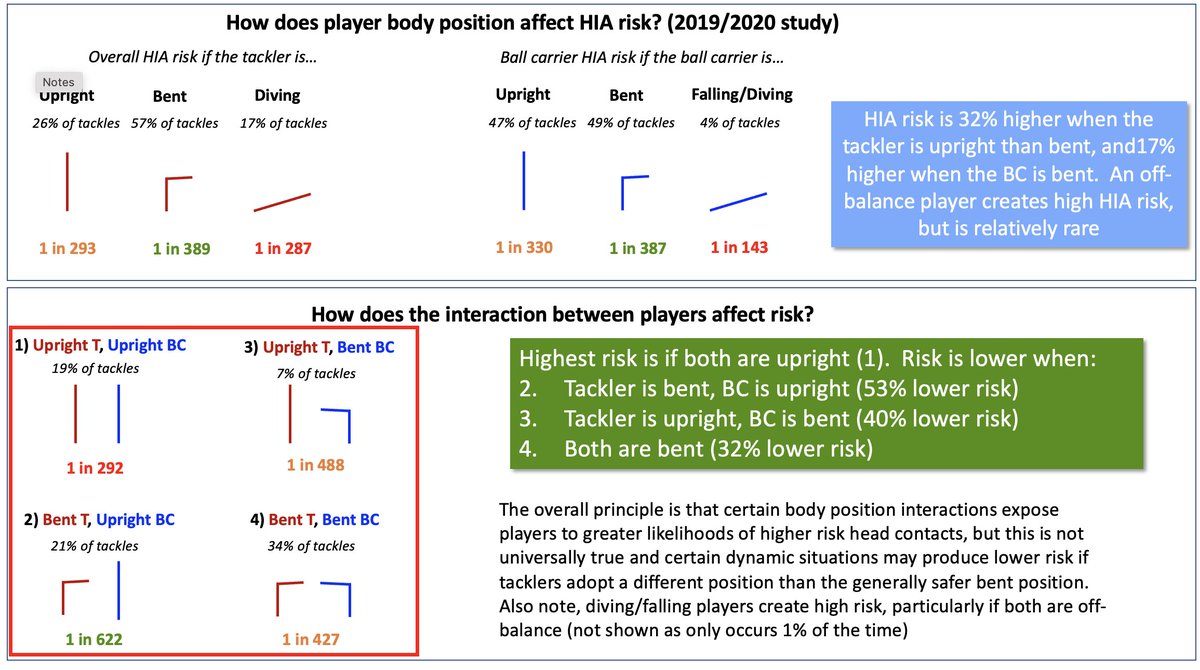
So, we have four combinations, and you can see the risk for each in the slide below:
1) Both T and BC upright - 1 in 292 causes an HIA
2) T bent, BC upright - 1 in 622
3) T upright, BC bent - 1 in 488
4) T bent, BC bent - 1 in 427
Clearly, highest risk is if both are upright
1) Both T and BC upright - 1 in 292 causes an HIA
2) T bent, BC upright - 1 in 622
3) T upright, BC bent - 1 in 488
4) T bent, BC bent - 1 in 427
Clearly, highest risk is if both are upright
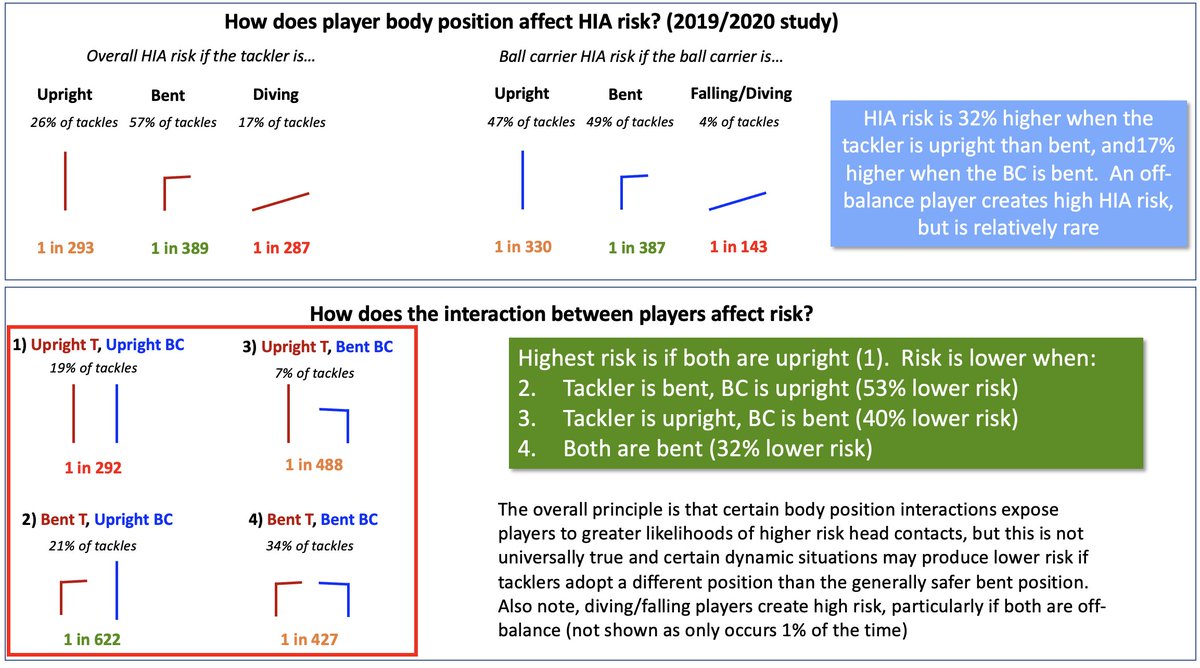
And, the lowest risk is when the T is bent & BC is upright. So let's just reassess what we've learned so far:
🏉 Upright players increase risk
🏉 Higher contacts (above sternum) of Tackler heads with BC body increase risk.
These two things are, I'm sure you appreciate, related
🏉 Upright players increase risk
🏉 Higher contacts (above sternum) of Tackler heads with BC body increase risk.
These two things are, I'm sure you appreciate, related
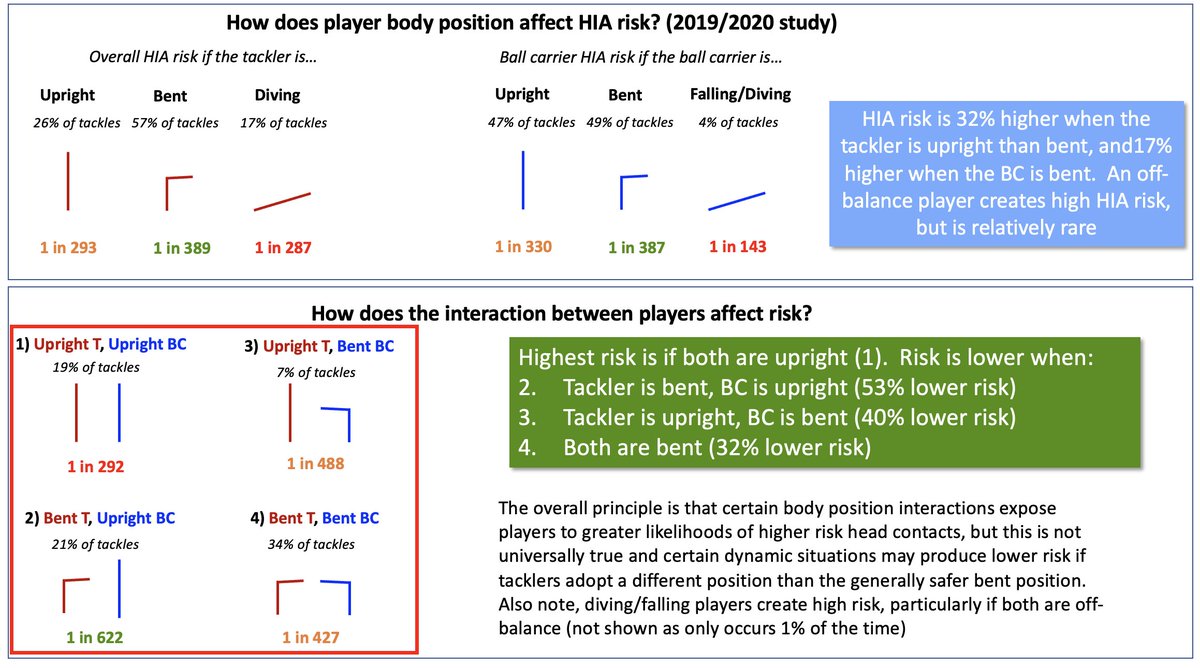
So, when these data were first found (end of 2016), they were presented to a group of coaches and players, who were asked "Given the risk you've now seen, what would you change to reduce the risk?". Remember our risk reduction principle & spectrum from earlier? 

What those coaches and rugby experts suggested was:
🏉 Reduce the height of contact between the tackler's head and the ball carrier's head. In other words, reduce how often "heads share airspace"
🏉 Do this by using stricter sanctions, to compel players to tackle lower (& bent)
🏉 Reduce the height of contact between the tackler's head and the ball carrier's head. In other words, reduce how often "heads share airspace"
🏉 Do this by using stricter sanctions, to compel players to tackle lower (& bent)
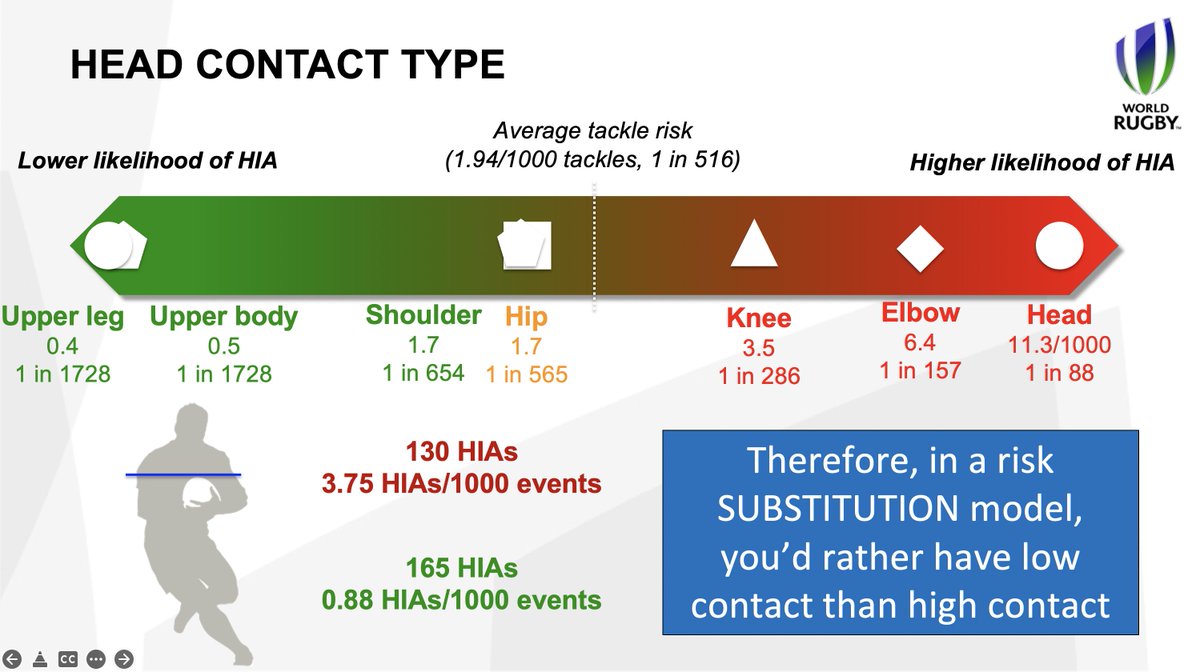
So, when you are watching rugby this weekend, if you see red and yellow cards for high tackles (and I hope you don't!), YOU'RE SEEING ATTEMPTS TO REDUCE RISK (sorry for caps!) by changing behaviour from high risk to low risk based on data. The desire is to nudge the height down
Or to force it down. Why? Because we know that relatively speaking, risk is lower when lower! Not zero, but lower, so a SUBSTITUTION strategy says we want heads near hips, not near heads and shoulders. We can identify three risk zones for head proximity - red, orange, & green. 
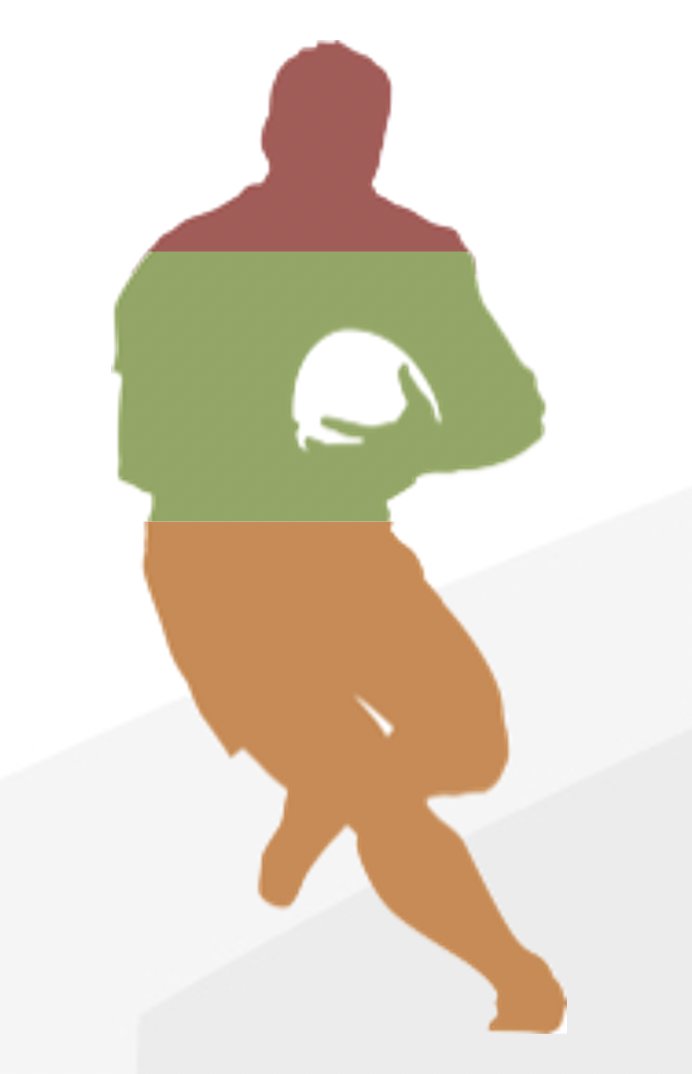
SANCTION CARRIES A MESSAGE - it says to players that they invite risk upon themselves if they are targeting high or upright. It says "Take responsibility for the potential negative outcomes of your tackle technique, both for your head and the opponent's head".
Now, the game is dynamic, fast, chaotic, complex. That's why there's controversy. Everyone understands that. But hopefully now you also understand the intention behind the sanction. A couple of thought experiments: Would the game be playable if legal tackle height was the waist?
And second, would we see accidental "rugby incidents" if the legal height of the tackle was the waist? In other words, what would happen if we FORCED the height down with law change, rather than "suggested" it through sanction of current law?
I think the game CAN be played lower, & that it would eliminate many of the "accidental" high tackles we currently see. The point being that risk is, to some degree, created by mindset. Law could change that, but it's a drastic change, which is why the "nudge" approach was used
Whether it's effective or not, time will tell. But the point of this thread is just to explain the "why" behind the sanctions, and hopefully to make clear that the sanction is the message. A message to substitute high for low risk behaviour. I hope it's being received!
Oh, one last thing. Many people reading this may say "Ah, but I watch a lot of rugby and I see a lot of head injuries from heads hitting hips, so lower must be more dangerous". If you think this, you're making a very basic risk management error (sorry to be blunt). Let me explain
The NUMBER of injuries you see from EVENT X is determined by TWO things: The risk of EVENT X, and the number of times EVENT X happens. For instance, more people died taking selfies than were killed by sharks in 2015. Do you conclude that selfies are more dangerous than sharks? 
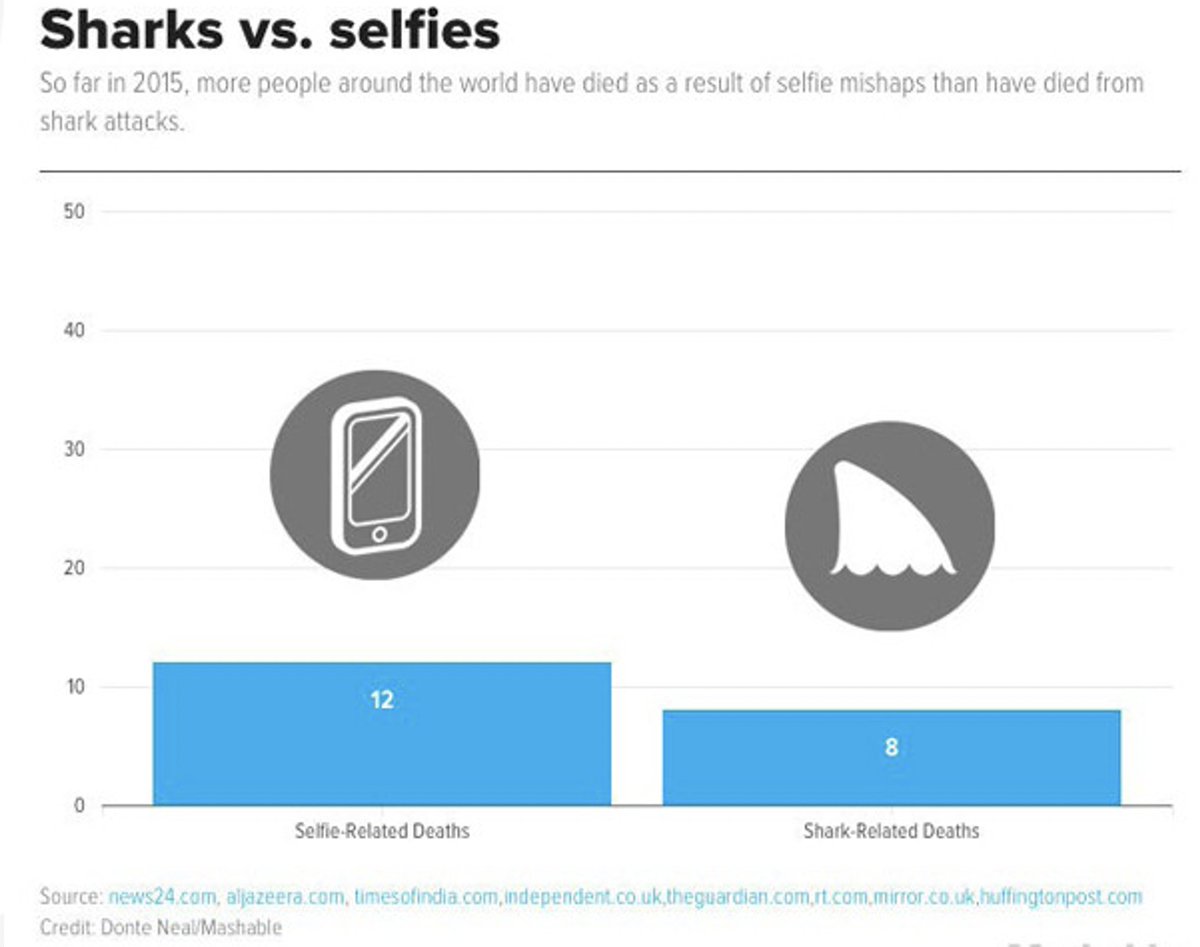
Or, do you think about it for a split second (that's all it takes!) & recognize that literally billions of selfies are taken, but only a small % of people are exposed to sharks every year? So the EXPOSURE to risk is crucial. That's why when we look at risk, we have "controls" 
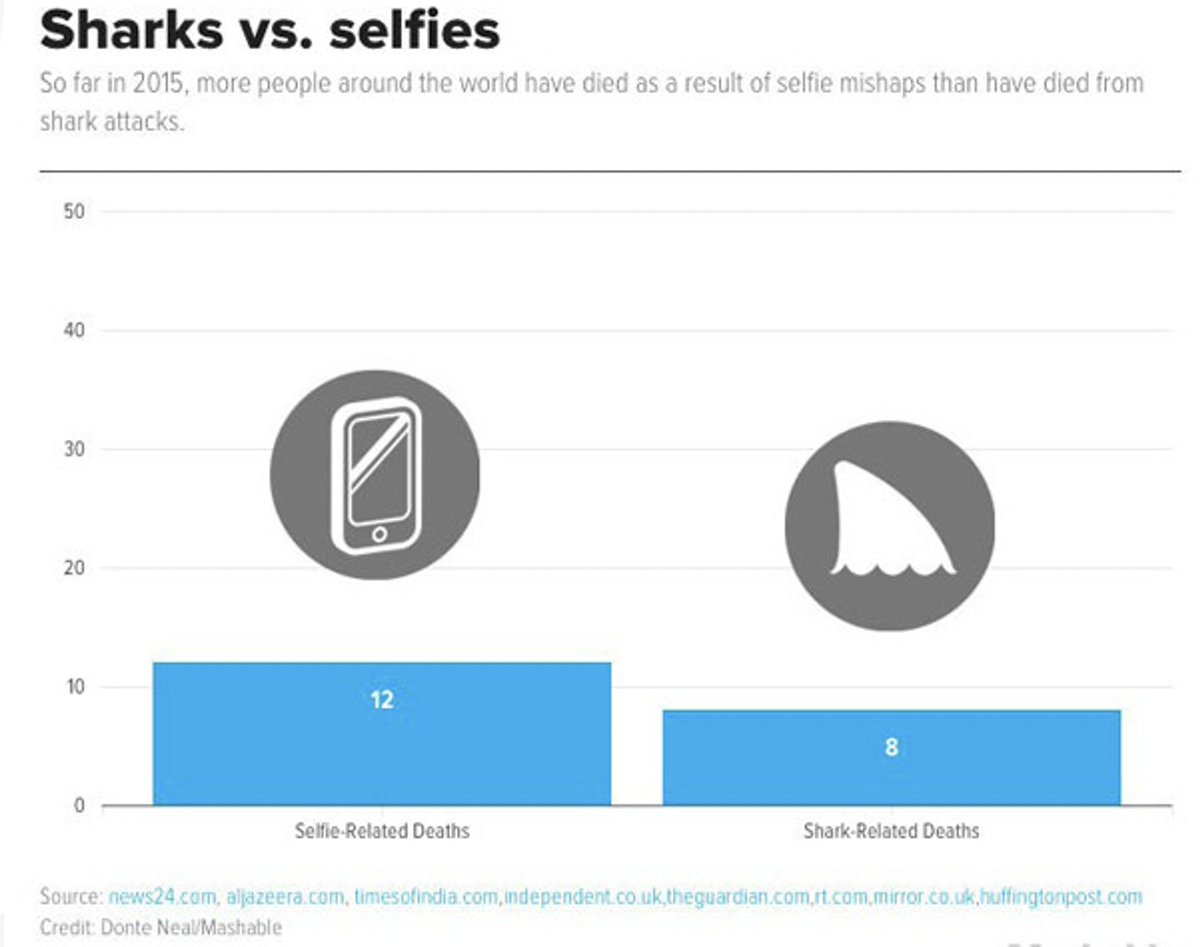
I've somehow messed up the linking of tweets in this thread, my bad. This is the one that should've come next, and finishes the story:
https://twitter.com/Scienceofsport/status/1547929610360279044?s=20&t=f8jjxl_Uo0oymKKFNaRHhA
• • •
Missing some Tweet in this thread? You can try to
force a refresh













